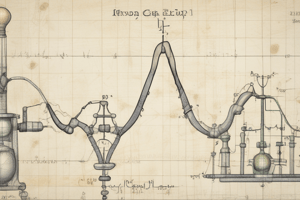Podcast
Questions and Answers
What is the term for the volume occupied by one mole of a gas?
What is the term for the volume occupied by one mole of a gas?
- Molar volume (correct)
- Molar concentration
- Partial volume
- Absolute volume
Which law describes the relationship between pressure and volume of a gas at constant temperature?
Which law describes the relationship between pressure and volume of a gas at constant temperature?
- Boyle's Law (correct)
- Avogadro's Law
- Dalton's Law
- Charles's Law
According to Avogadro's Law, what is the molar volume of any gas at standard temperature and pressure (STP)?
According to Avogadro's Law, what is the molar volume of any gas at standard temperature and pressure (STP)?
- 11.2 l/mol
- 22.4 l/mol (correct)
- 33.6 l/mol
- 44.8 l/mol
What does Dalton's Law of Partial Pressures state?
What does Dalton's Law of Partial Pressures state?
What is the ideal gas equation?
What is the ideal gas equation?
How can Boyle's Law be mathematically expressed for two measurements of the same gas?
How can Boyle's Law be mathematically expressed for two measurements of the same gas?
Which factor is NOT part of Dalton's Law of Partial Pressures?
Which factor is NOT part of Dalton's Law of Partial Pressures?
Which physical property allows a gas to become saturated with water vapor?
Which physical property allows a gas to become saturated with water vapor?
Flashcards are hidden until you start studying
Study Notes
Molar Volume of a Gas
- Molar volume is the number of liters occupied by one mole of a gas.
- The molar volume of an ideal gas depends on temperature and pressure.
- At a fixed temperature and pressure, Boyle's Law can be used to describe the relationship between pressure and volume.
- Boyle's Law states: $PV = constant$ or $P_1V_1 = P_2V_2$
- Avogadro's Law states that the molar volume of any gas at STP (273 K and 1 atm) is 22.4 L/mol.
- Partial pressure is the pressure exerted by a single gas in a mixture.
- The total pressure of a mixture is the sum of the partial pressures of each gas: $P_{total} = P_1 + P_2 + ...$
- This phenomenon is known as Dalton's Law of Partial Pressures.
Gas Mixtures
- A gaseous mixture is created when a gas comes into contact with water and gets saturated with water vapor.
- The partial pressure of water vapor can be found using Table 1, which shows the relationship between temperature and partial pressure of water vapor.
Studying That Suits You
Use AI to generate personalized quizzes and flashcards to suit your learning preferences.




